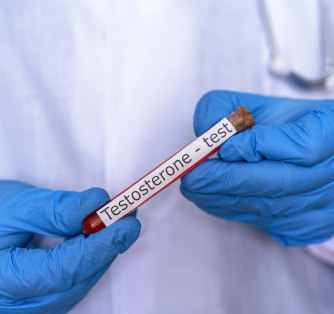Menu
Weight loss
Hormones
Sex
EXPLORE
MEET NU IMAGE MEDICAL
TREATMENTS
MEET NU IMAGE MEDICAL
TREATMENTS
MEET NU IMAGE MEDICAL
Testosterone Blood Test: How It's Done and Results Explained


If you’re a man with low testosterone or a desire to boost testosterone levels, you may have heard about the testosterone blood test. Used to measure a man’s testosterone levels, a testosterone blood test can give you the information you need to bring your testosterone to normal levels.
By keeping an eye on your testosterone levels, you stand a better chance of raising testosterone levels and restoring your body to normal functioning. But what is a testosterone blood test, and how does it work?
According to experts, a testosterone blood test is used to measure the amount of testosterone in a man’s blood. Although a testosterone blood test is used primarily to determine testosterone levels in a man’s blood, doctors can also use this test to “monitor” hormone levels in those who are receiving testosterone replacement therapy or TRT.
Transgender men undergoing hormone therapy also benefit from this test. A healthcare provider will get a blood sample from a vein in one of your arms. Once the needle is inserted into a vein, your healthcare provider will collect a small blood sample. The blood will be placed in a vial or test tube.
Men with erectile dysfunction or a low sex drive may also have this test done to see if hormone levels are impacting the body and causing problems. However, it also helps to know what symptoms may indicate that you need a testosterone blood test.
A lack of body or facial hair, a lower voice, male pattern baldness, and having “thinning bones” may indicate that you have low testosterone. Much like other testosterone boosting drugs, a testosterone blood test is typically administered between 7:00 a.m. and 10:00 a.m., primarily because that’s when testosterone levels are the highest.
Testosterone levels tend to fluctuate. However, testosterone levels are typically higher around 8:00 in the morning, according to the New York Times. Normal levels of testosterone, as a rule, hover between 300 and 1,000 nanograms per deciliter.
To prepare for this test, you should be aware of a number of things. In some cases, you may be required to fast for a number of hours. This is required in only some cases. With fasting, you must avoid eating and drinking for several hours before having this test done.
Your doctor may have specific instructions for you, depending on your situation. Because of this, it is a good idea to discuss your situation with your healthcare provider. You may also ask your doctor if he or she has specific instructions for you. Be sure to follow your doctor’s instructions for fasting, as eating a meal even one or two hours before the test can result in a 47 percent drop in testosterone levels.
This may make it difficult to get an accurate reading. In fact, eating a few hours before the test can make it difficult to get an accurate reading, since levels are usually different between morning and afternoon. Not fasting can make it difficult to read different levels, as levels usually differ between 20 and 25 percent between the morning and afternoon.
Some men may be concerned about the risks of this test. However, experts assert that there are little to no risks associated with this test. You may experience pain or bruising at the injection site, but these typically go away quickly.
Your body operates at maximum capacity when your testosterone levels are normal. Abnormal testosterone levels can result in a number of problems, including an abnormal development of reproductive function. Additionally, some people may also experience a change in sex drive.
This test is typically conducted in a doctor’s office or other medical facility. Testosterone lives in your body as a free testosterone. This means that it is attached to nothing else. Bound testosterone, on the other hand, is “attached to proteins.” Your body has an easier time using free testosterone.
Free testosterone is essential to your health, because it exists in your veins. When your doctor performs a testosterone test, he or she might check your free testosterone and total testosterone levels. But what is total testosterone testing? According to experts, total testosterone is a measurement of both bound and free testosterone.
Both types of testosterone regulate a number of functions, including the following:
-
Erectile function
-
Sperm production
-
Red blood cell production
-
Muscle mass
-
Hair growth
When your blood specimen is analyzed, your healthcare provider will look to see if your levels are high, low, or within normal range. Your age and sex often determine the results of your test. Low levels of testosterone can be indicative of a number of problems, including pituitary gland problems, typical aging, or potentially tumors.
Your doctor may ask you to have a testosterone test if you show symptoms of high testosterone as well. But what do the results of a testosterone test show? A testosterone test tells you what your total testosterone levels are. A testosterone test also looks at a number of other factors. It can also determine whether or not conditions, like erectile dysfunction, are the cause of low testosterone.
Men with low testosterone may have trouble getting their partner pregnant. A testosterone test can determine if low testosterone is the cause of this. In many cases, a man has low blood testosterone, which causes this problem. You may want to get this test if you are having trouble concentrating, decreased muscle mass, or swollen breasts.
Low testosterone can be caused by a number of factors, including testicular injury or testicular cancer, chronic diseases, infections, or low thyroid function. It’s important to remember that testosterone affects other aspects of a man’s health, including muscle endurance, mood, and energy.
Someone with delayed puberty may also benefit from having a testosterone test. According to PubMed, requests for testosterone tests have increased in recent years, and studies have analyzed the pathology of levels of testosterone in men.
A testosterone test measures androgen levels in the blood. Testosterone itself is made in the testicles. When testosterone levels are low, the pituitary gland releases luteinizing hormone (LH), a hormone responsible for triggering the release of testosterone from the testes. LH is tied to neurological functions, including function of the hypothalamus and gonads.
Understanding what normal testosterone levels are is essential to understanding the results of your test. Ideally, you want your testosterone levels to be a minimum of 300, but unfortunately, many men fall short of this. Experts say it is a good idea to have more than one test. These tests should be spaced, so a second test may be performed weeks or months after the first one.
Having testosterone levels below 300 is cause for concern. You should not be too worried if your levels are just slightly below normal range. However, a dramatically low testosterone level may necessitate further treatment. If you have other worrisome symptoms, you should meet with your doctor.
If your levels are just slightly low, you need to exhibit other symptoms that indicate a problem. These symptoms may not be obvious at first. Other less common symptoms of low testosterone include depressed mood, fatigue, and poor quality and infrequent erections.
Doctors usually recommend testosterone tests for men with certain medical conditions. These conditions may include infertility and low muscle mass. In some cases, hair loss may be a reason to have a testosterone test. However, in many cases, hair loss is the result of genetics.
A testosterone test does require some preparation. Your doctor will give you specific instructions, which will depend upon your personal situation. Before administering this test, your healthcare provider may place rubbing alcohol on your arm where the needle will be inserted.
But what are the results of this test? According to the Cleveland Clinic, low levels of testosterone may indicate glandular problems. Low testosterone may point to problems, such as Klinefelter syndrome or undescended testicles. Klinefelter syndrome is a condition in which a man is born with an “extra X chromosome.
High levels of testosterone are indicative of adrenal gland problems or issues with the testicles. But what should you expect when you get a diagnosis? According to experts, low testosterone is sometimes caused by other preexisting conditions, like sleep apnea and diabetes.
If your low testosterone is caused by a preexisting condition, your doctor may first treat the condition he or she expects is causing problems with testosterone. Your doctor may also recommend that you make lifestyle changes, such as exercise, diet, and stress management. While these changes are not guaranteed to solve the problem, this is a good first step.
Kicking unhealthy habits and adopting healthy habits may help minimize the symptoms of low or high testosterone levels. Research has found that men who participate in three and a half hours of moderate aerobic exercise per week typically see improvements in sexual function and testosterone levels.
However, men who are overweight and have excess belly fat can benefit from adopting a healthy lifestyle like this. Your doctor may recommend testosterone replacement therapy as a treatment for low testosterone.
14 Sources
Nu Image Medical has strict sourcing guidelines to ensure our content is accurate and current. We rely on peer-reviewed studies, academic research institutions, and medical associations. We strive to use primary sources and refrain from using tertiary references.
https://www.nytimes.com/2018/03/27/well/live/testosterone-supplements-low-t-treatment-libido.html
https://medlineplus.gov/lab-tests/testosterone-levels-test/
https://www.testing.com/tests/testosterone/
https://ro.co/health-guide/free-testosterone/
https://medlineplus.gov/ency/patientinstructions/000722.htm
https://www.healthline.com/health/unable-to-concentrate
https://pubmed.ncbi.nlm.nih.gov/22299206/
https://www.ncbi.nlm.nih.gov/books/NBK539692/
https://www.webmd.com/men/features/keep-testosterone-in-balance
https://my.clevelandclinic.org/health/diagnostics/24215-testosterone-test
https://my.clevelandclinic.org/health/diseases/21116-klinefelter-syndrome
https://www.testing.com/tests/testosterone/
https://www.mountsinai.org/health-library/tests/testosterone
This article is for informational purposes only and does not constitute medical advice. The information contained herein is not a substitute for and should never be relied upon for professional medical advice. Always talk to your physician about the risks and benefits of any treatment. Nu Image Medical may not offer the medications or services mentioned in this article.
